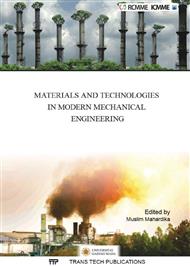[1]
C.K. Hsu, The Preparation of Biphasic Porous Calcium Phosphate by the Mixture of Ca(H2PO4)2·H2O and CaCO3. Materials Chemistry and Physics, 80, (2003) 409-420.
DOI: 10.1016/s0254-0584(02)00166-9
Google Scholar
[2]
R. Murugan and S. Ramakrishna, Development of nanocomposites for bone grafting. Compos Sci Technol 65 (2005) 2385–2406.
Google Scholar
[3]
S.J. Kalita, A. Bhardwaj and H.A. Bhatt, Nanocrystalline calcium phosphate ceramics in biomedical engineering. Mater Sci Eng C 27 (2007) 441–449.
DOI: 10.1016/j.msec.2006.05.018
Google Scholar
[4]
L.B. Kong, J. Ma and F. Boey Nanosized hydroxyapatite powders derived from coprecipitation process. J Mater Sci 37 (2002) 1131–1134.
Google Scholar
[5]
P. Habibovic, M.C. Kruyt, M.V. Juhl, S. Clyens, R. Martinetti, L. Dolcini, N. Theilgaard and C. Av. Blitterswijk, Comparative in vivo study of six hydroxyapatite-based bone graft substitutes. J Orthop Res 26 (2008) 1363–1370.
DOI: 10.1002/jor.20648
Google Scholar
[6]
J.L. Simon, S. Michna, J.A. Lewis, E.D. Rekow, V.P. Thompson, J.E. Smay, A. Yampolsky, J.R. Parsons and J.L. Ricci, In vivo bone response to 3D periodic hydroxyapatite scaffolds assembled by direct ink writing. J Biomed Mater Res A 83 (2007).
DOI: 10.1002/jbm.a.31329
Google Scholar
[7]
S.A. Clarke, N.L. Hoskins, G.R. Jordan, S.A. Henderson and D.R. Marsh, In vitro testing of advanced JAX TM bone void filler system: Species differences in the response of bone marrow stromal cells to b tri-calcium phosphate and carboxymethylcellulose gel. J Mater Sci Mater Med 18 (2007).
DOI: 10.1007/s10856-007-3099-1
Google Scholar
[8]
S. J. Kalita, R. Fleming, H. Bhatt, B. Schanen, and R. Chakrabarti, Development of controlled strength-loss resorbable beta-tricalcium phosphate bioceramic structures, Materials Science and Engineering C 28 (2008) 392–398.
DOI: 10.1016/j.msec.2007.04.007
Google Scholar
[9]
A. C. Tas, F. Korkusuz, M. Timucin and N. Akkas, An investigation of the chemical synthesis and high-temperature sintering behavior of calcium hydroxyapatite (HA) and tricalcium phosphate (TCP) bioceramics. J. Mat. Sci.: Mat. Med., 8 (1997) 91-96.
Google Scholar
[10]
N. Kivrak and A.C. Tas, Synthesis of Calcium Hydroxyapatite-Tricalcium Phosphate Composite Bioceramic Powders and their Sintering Behavior Journal of The American Ceramic Society, 81 (1998) 2245-2252.
DOI: 10.1111/j.1151-2916.1998.tb02618.x
Google Scholar
[11]
R. W. N. Nilen and P. W. Richter, The Thermal Stability of Hydroxyapatite in Biphasic Calcium Phosphate Ceramics, J Mater Sci: Mater Med 9, No. 4 (2008) 1693-1702.
DOI: 10.1007/s10856-007-3252-x
Google Scholar
[12]
U. Ripamonti, P. W. Richter, R. W. N. Nilen and L. Renton, The induction of bone formation by smart biphasic hydroxyapatite tricalcium phosphate biomimetic matrices in the non-human primate Papio ursinus, Journal of Cellular and Molecular Medicine 12 (2008).
DOI: 10.1111/j.1582-4934.2008.00312.x
Google Scholar
[13]
S.P. Victor and T.S. Kumar, Tailoring calcium-deficient hydroxyapatite nanocarriers for enhanced release of antibiotics. J. Biomed. Nanotechnol. 4 (2008) 1–7.
Google Scholar
[14]
D. Tadic and M. Epple, A Thorough Physicochemical Characterization of 14 Calcium Phosphate-based Bone Substitution Materials in Comparison to Natural Bone. Biomaterials, 25 (2004) 987–994.
DOI: 10.1016/s0142-9612(03)00621-5
Google Scholar
[15]
W. Suchanek and M. Yoshimura, Processing and properties of hydroxyapatite-based biomaterials for use as hard tissue replacement implants, J. Mater. Res., 13 (1998) 94-11.
DOI: 10.1557/jmr.1998.0015
Google Scholar
[16]
D.J. Griffon, Evaluation of osteoproductive biomaterials: allograft, bone inducing agent, bioactive glass and ceramics, Academic Dissertation, Department of Clinical Veterinary Sciences, Division of Surgery Faculty of Veterinary Medicine, University of Helsinki, Finland (2002).
Google Scholar
[17]
A.J. Salgado, O.P. Coutinho and R.L. Reis, Bone Tissue Engineering: State of the Art and Future Trends, Macromol. Biosci., 4 (2004) 743-765.
DOI: 10.1002/mabi.200400026
Google Scholar
[18]
M. Vallet-Regi and J.M. Gonzalez-Calbet, Calium phosphates as substitution of bone tissues, Progress in Solid State Chemistry, 32 (2004) 1-31.
Google Scholar
[19]
JCPDS File No. 9-432 (hydroxyapatite), Joint Committee on Powder Diffraction Standards, Swathmore, PA (1988).
Google Scholar
[20]
JCPDS File No. 9-169 (β-tricalcium phosphate, β-TCP), Joint Committee on Powder Diffraction Standards, Swathmore, PA (1988).
Google Scholar
[21]
R. Murugan, T.S. Sampath-Kumar and P.K. Rao, Fluorinated Bovine Hydroxyapatite: Preparation and Characterization. Materials Letters, 57 (2002) 429- 433.
DOI: 10.1016/s0167-577x(02)00805-4
Google Scholar
[22]
S. Joschek, B. Nies, R. Krotz and A. Göpferich, Chemical and physicochemical characterization of porous hydroxyapatite ceramics made of natural bone, Biomaterials, 21 (2000) 1645-1658.
DOI: 10.1016/s0142-9612(00)00036-3
Google Scholar
[23]
M.A. Walters, Y.C. Leung, N.C. Blumenthal, R.Z. LeGeros and K.A. Konsker, A Raman and Infrared Spectroscopic Investigation of Biological Hydroxyapatite. J Inorg Biochem., 39 (1990) 193-200.
DOI: 10.1016/0162-0134(90)84002-7
Google Scholar
[24]
M. Markovic, B.O. Fowler and M.S. Tung, Preparation and Comprehensive Characterization of a Calcium Hydroxyapatite Reference Material. J. Res. Natl. Inst. Stand. Technol., 109 (2004) 553-568.
DOI: 10.6028/jres.109.042
Google Scholar
[25]
F.H. Lin, C.J. Liao, K.S. Chen, and J.S. Sun, Preparation of a Biphasic Porous Bioceramic by Heating Bovine Cancellous Bone with Na4P2O7. 10H2O Addition. Biomaterials, 20, (1999) 475-484.
DOI: 10.1016/s0142-9612(98)00193-8
Google Scholar


